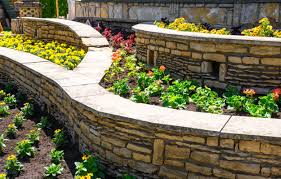When it comes to landscape design, functionality and aesthetics must go hand in hand to create spaces that are both attractive and practical. While greenery and outdoor furnishings often receive the most attention, one underrated hero in the architectural and aesthetic harmony of landscape design is the use of retaining wall blocks. In this article, we will explore how these structural elements can enhance the beauty and usability of outdoor spaces.
Understanding Retaining Wall Blocks
Retaining wall blocks are a versatile construction material used to support soil laterally so that it can be retained at different levels on the two sides. Traditionally, they have been used to tackle erosion, manage slopes, and optimise land use in both residential and commercial settings.
Aesthetic Appeal
From an aesthetic standpoint, retaining wall blocks introduce an element of texture and form that can complement any landscape design. Whether you choose a natural stone look or a more contemporary finish, these blocks can create stunning visuals that enhance the overall appearance of your outdoor space.
Designer landscapes often integrate retaining walls as focal points or to blend seamlessly with the surrounding topography. Their variety in colours, sizes, and textures offers countless creative possibilities. You can craft everything from a simple raised garden bed to intricate outdoor retreats that provide relaxation and beauty.
Using retaining wall blocks, landscapers can convert a mundane slope into a series of terraces, planting spots, or even water features, adding dimensions to the landscape that otherwise would be unachievable. This shape-shifting feature of retaining blocks is key to achieving a harmonious balance between the natural lay of the land and the structured elements introduced during design.
Functional Advantages
Aside from aesthetics, retaining wall blocks serve numerous functional purposes. On a practical level, they can significantly reduce the impact of erosion and sedimentation, which are common concerns in areas with undulating terrain. By holding back soil, these walls help to prevent it from washing away during rainstorms, ensuring that your garden remains intact and well-structured.
Additionally, retaining wall blocks contribute to improved drainage in your garden. Properly constructed retaining walls can channel away excess water, protecting the foundations of nearby structures and preventing waterlogging of plants. This aspect of retaining walls is crucial for maintaining a healthy and thriving landscape.
In urban landscapes where space is at a premium, retaining walls provide a solution for creating usable flat areas on sloping ground. They enable the division of a garden into distinct sections, maximising the usability of outdoor areas. As a result, you can increase the effective leisure or gardening space of your property, elevating its value and utility.
Durability and Maintenance
Longevity is another key advantage of incorporating retaining wall blocks into your landscape design. Made to endure harsh conditions, high-quality blocks are built to last, requiring minimal ongoing maintenance. This makes them a cost-effective solution in the long term, as they often stand the test of time and harsh weather.
Maintenance is generally straightforward. Periodic inspections to ensure that the structural integrity remains intact and simple cleaning to maintain their appearance are typically all that is required. Over the years, maintaining the strength and look of the retaining walls is a relatively low-effort task compared to other elements of landscape maintenance.
High-quality retaining wall blocks are also resistant to pests and decay—common issues in other natural materials such as timber. This resistance increases the longevity of your landscape elements and keeps your outdoor space visually appealing for years to come.
Implementation in Design
To fully harness the benefits of retaining wall blocks in landscape design, it is essential to plan thoughtfully and carefully. Integration with the existing landscape, scale, material choice, and function should all be considered. Professionals in landscape design can assess the needs of the space, account for any legal or environmental constraints, and execute the design effectively.
Advancements in the manufacturing of retaining blocks have also increased the ease of installation without compromising on the structural integrity of the walls. Modular and interlocking systems facilitate rapid and reliable construction, allowing for more intricate and involved designs to be realised without significant increases in labour or cost.
When planning a project with retaining wall blocks, it is essential to work with materials that are of high quality and suited to the environmental conditions of your location. Reliability and strength are paramount, as retaining walls often serve as foundational elements in the landscape.
Conclusion
The incorporation of retaining wall blocks into landscape designs offers a perfect blend of beauty and functionality. These walls not only serve as powerful tools to prevent erosion and manage space but also add structured elegance to outdoor areas. With the right design and construction, retaining walls can create sophisticated textures and patterns, add new functional areas to your property, and significantly enhance the overall outdoor experience.
With the insights provided in this article, it is clear that retaining wall blocks are more than just practical necessities; they are key elements that contribute to the creation of captivating and sustainable landscapes. For landowners aiming to upgrade their outdoor spaces or manage difficult terrain, retaining wall blocks represent a solution that ticks both the boxes of aesthetics and utility.
also read: From Wearables to Wellness: How Smart Fashion Is Redefining Health and Lifestyle
